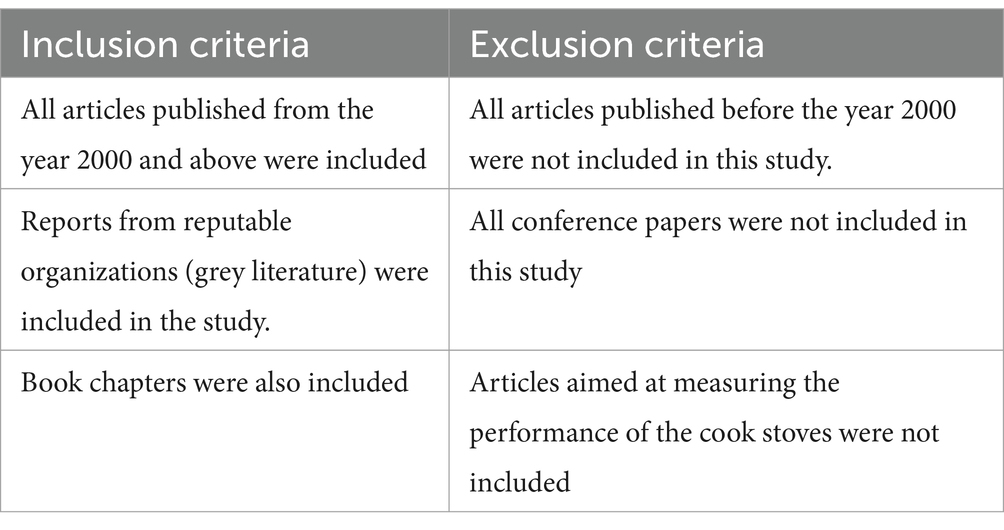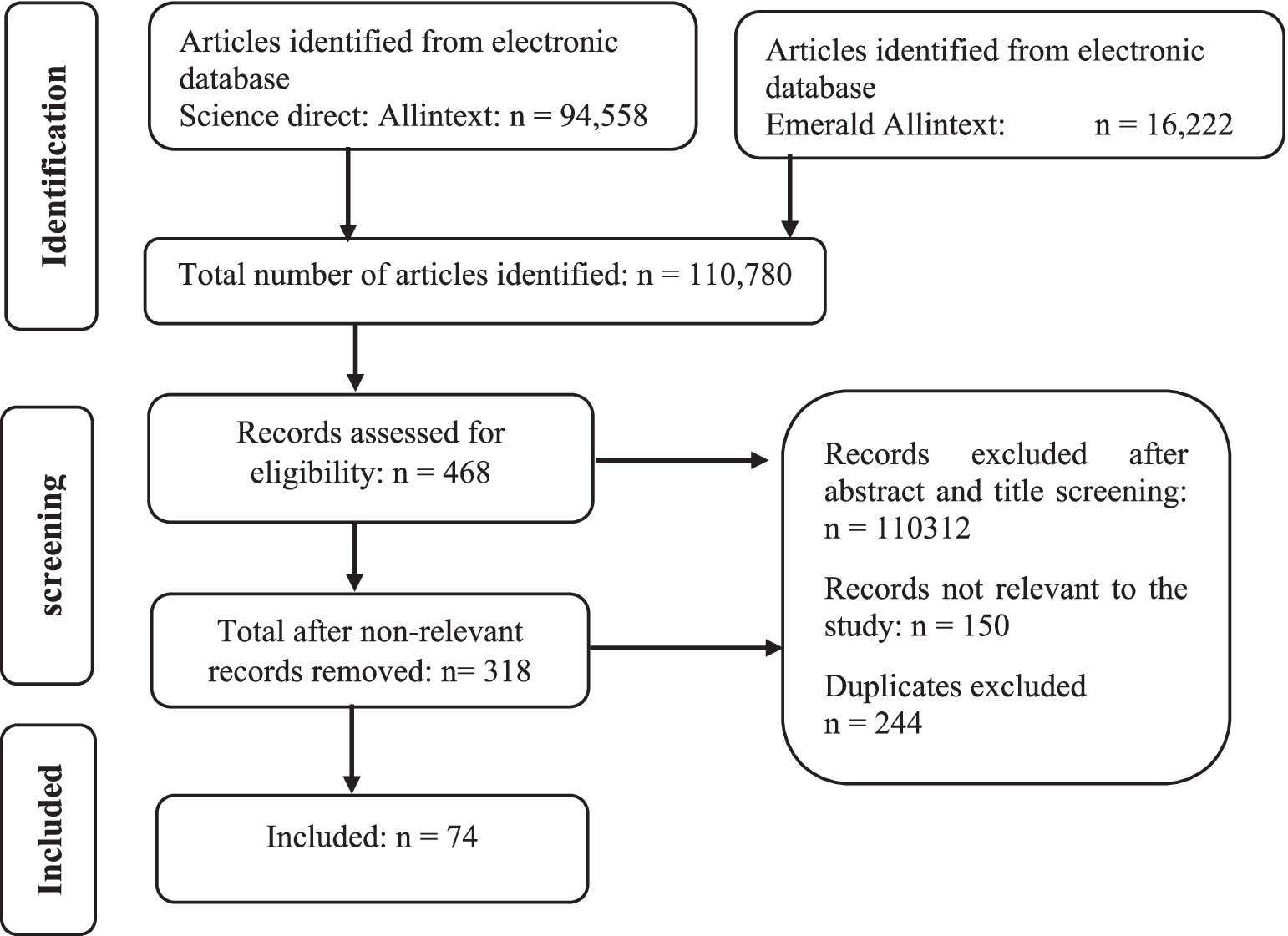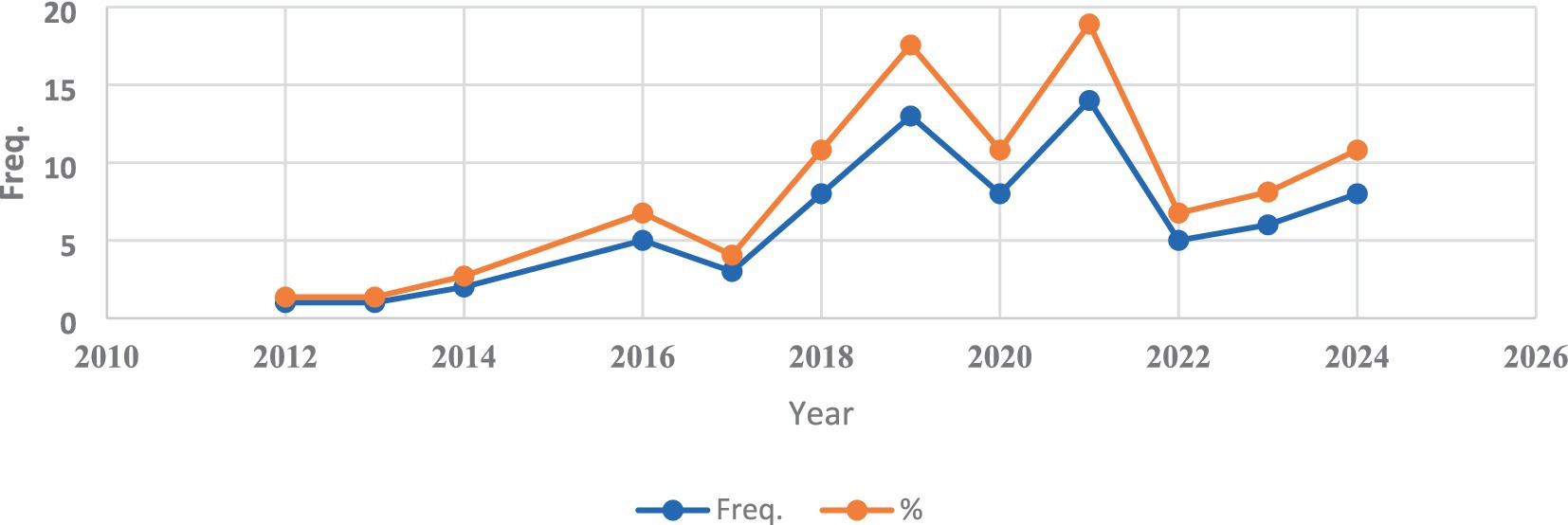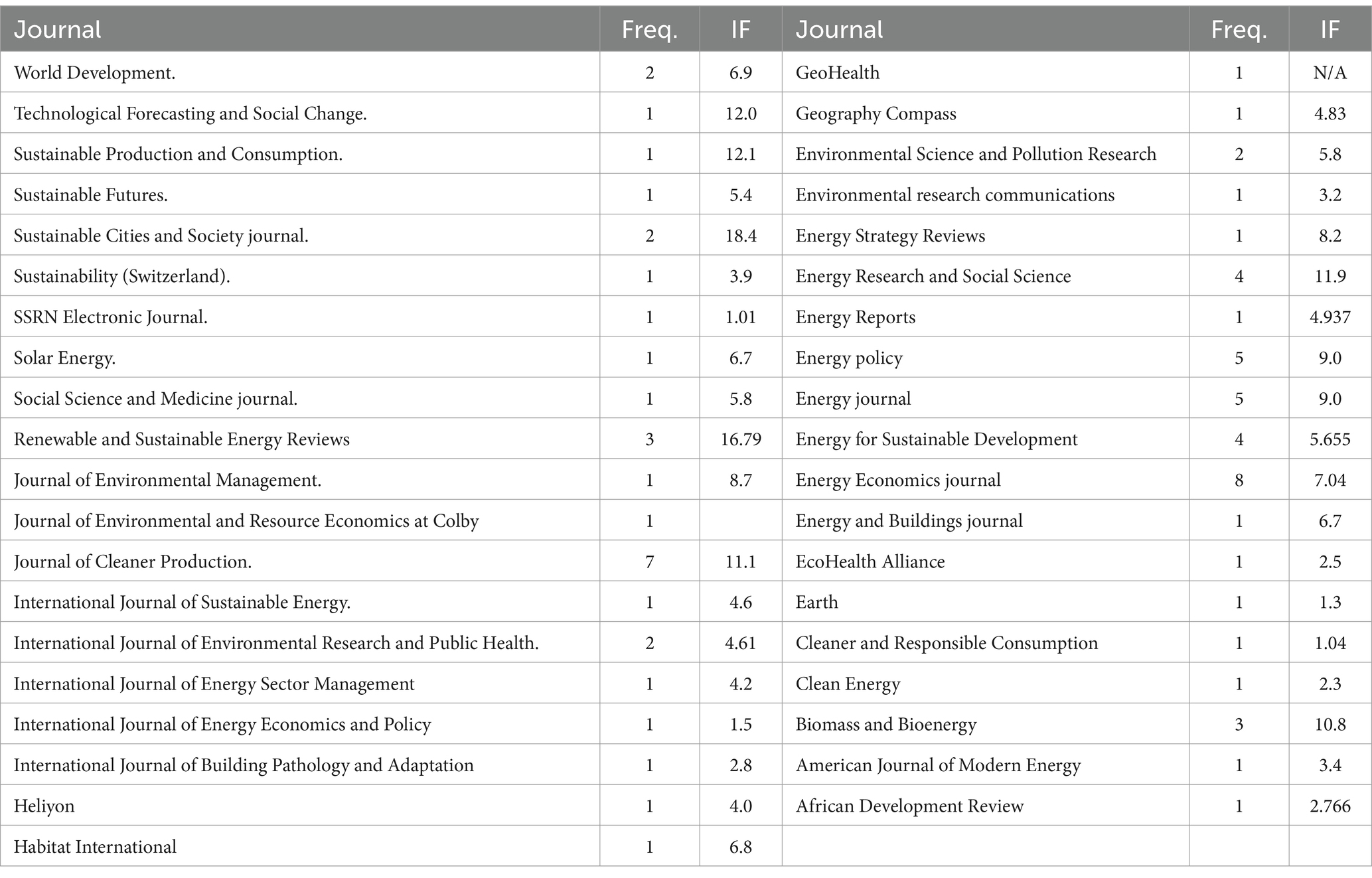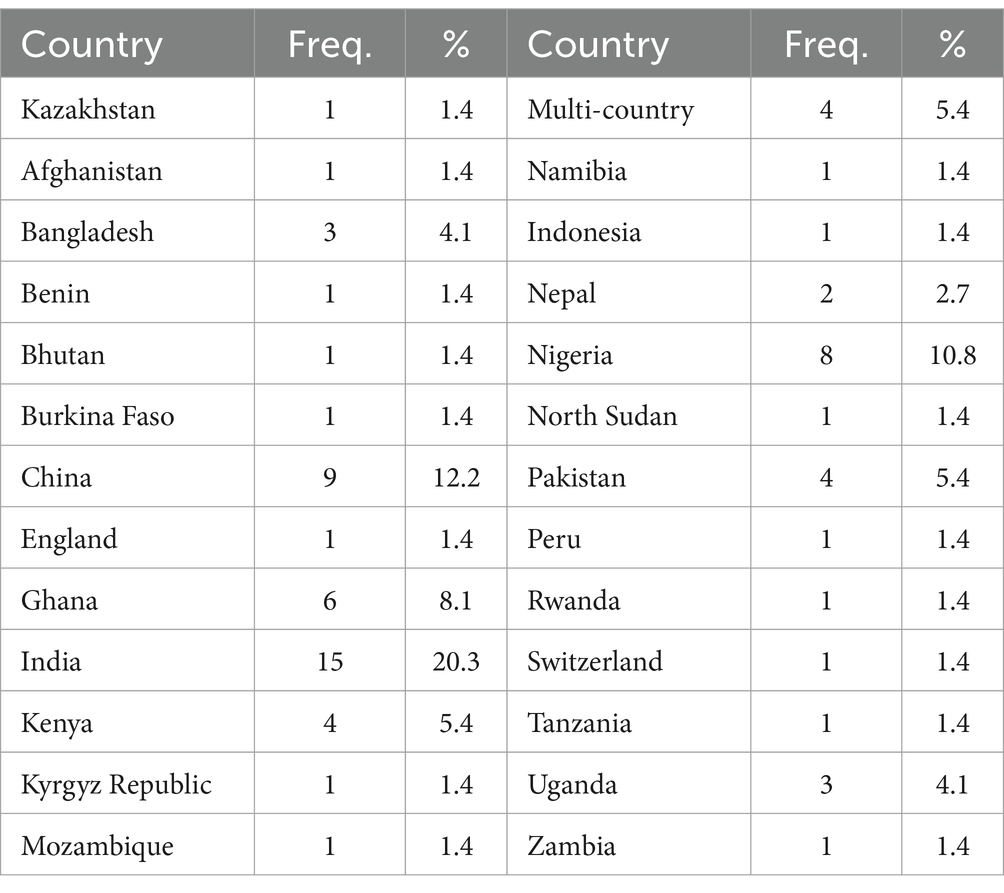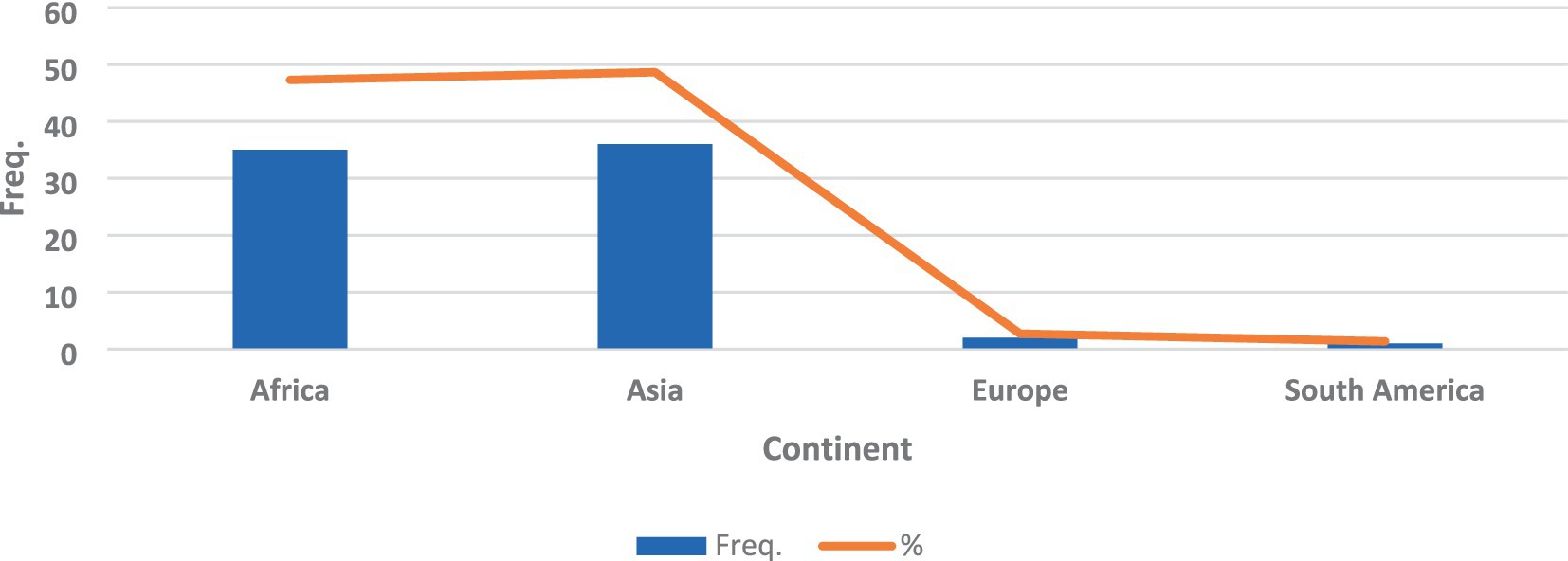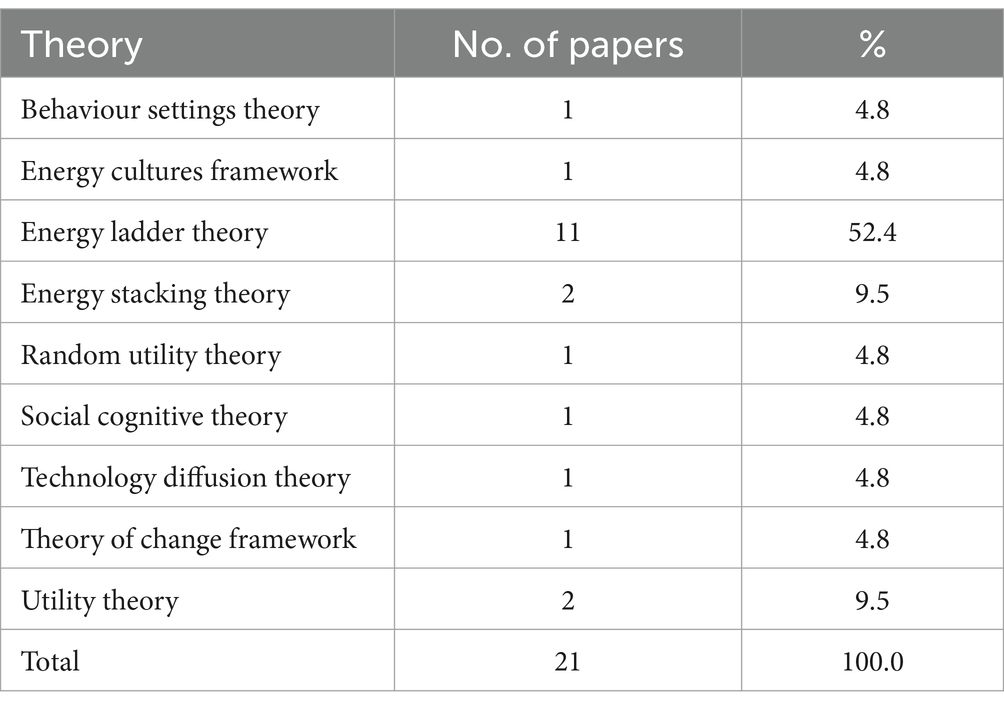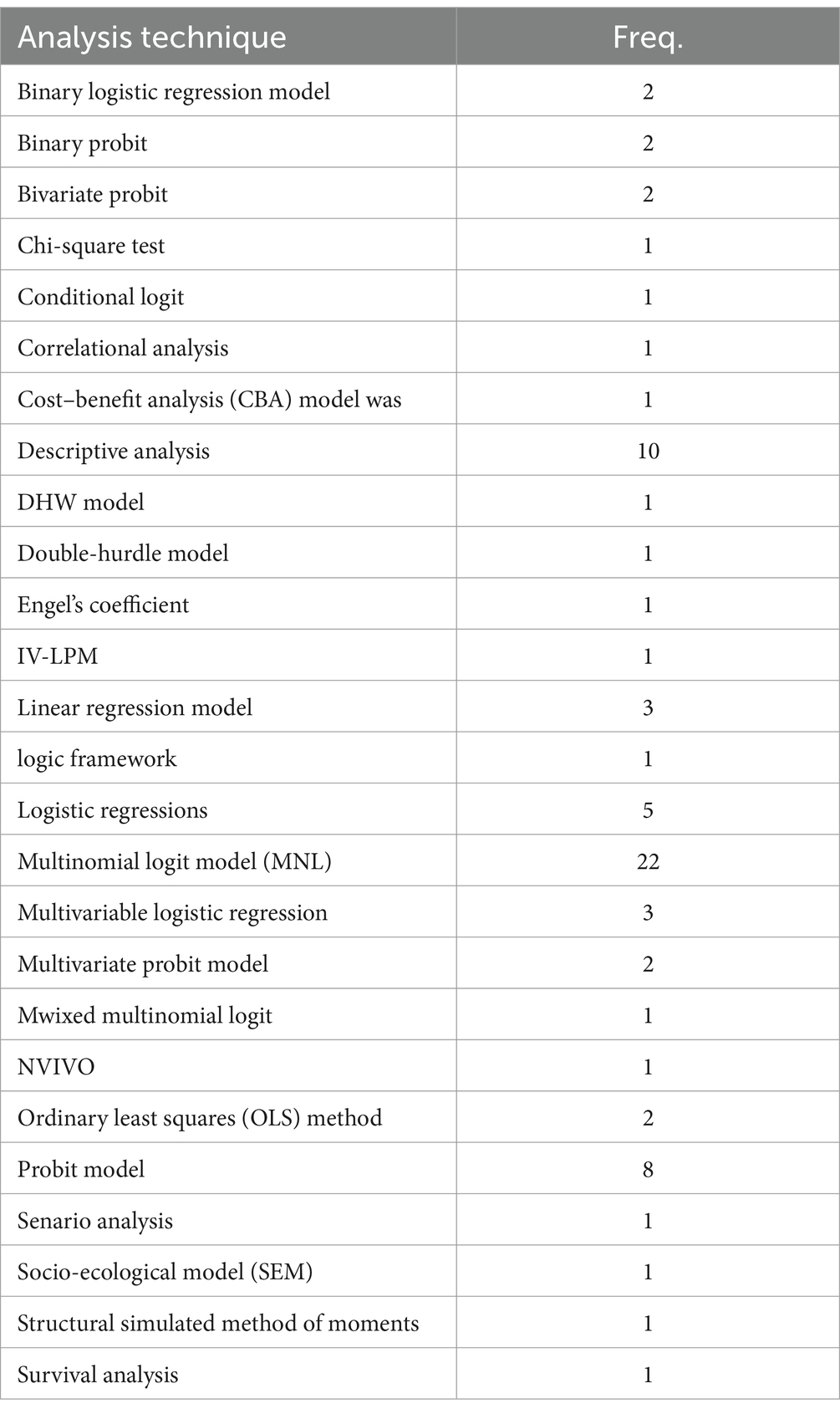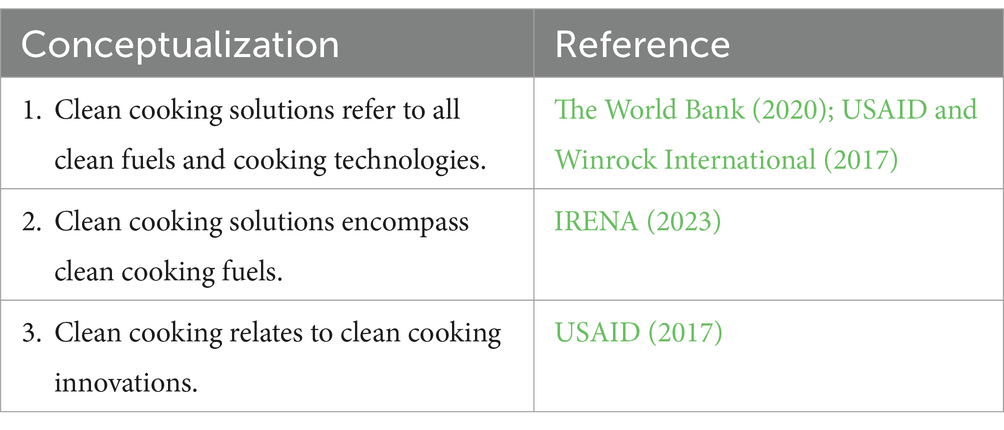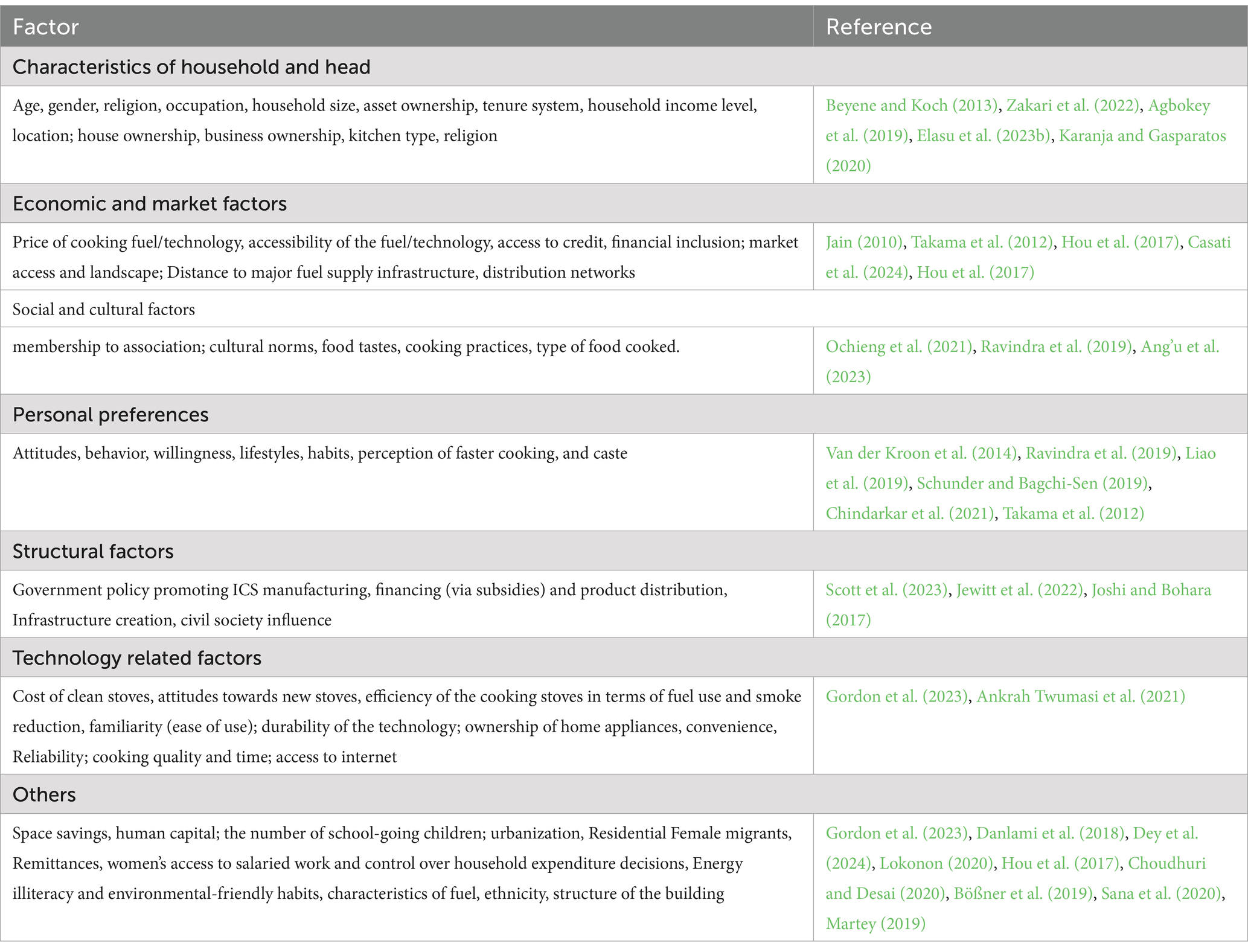- 1Faculty of Energy Economics and Management Science, Makerere University Business School, Kampala, Uganda
- 2Faculty of Graduate Studies and Research, Makerere University Business School, Kampala, Uganda
- 3Department of Geology and Petroleum Studies, Makerere University, Kampala, Uganda
- 4Department of Applied Economics, Makerere University Business School, Kampala, Uganda
Nearly half of the global population rely on solid polluting fuels such as firewood, charcoal, animal and plant wastes for cooking. Continued reliance on such fuels and technologies has severe negative health, environmental, and development impacts. Using a systematic literature review methodology, this study sought to unveil factors influencing choice of clean cooking solutions among households. This study adopted a systematically literature review approach to systematically identify, evaluate and synthesize articles in the field of clean cooking solutions. Systematic literature review is a rigorous and replicable methodology that is designed to identify, appraise and synthesize already existing literature on specific question or sub questions. In this study, the procedures suggested by Liberati et al. and Moher et al. based on preferred reporting items for systematic reviews and meta-analysis (PRISMA) approach. Seventy-four articles were synthesized and many factors influencing the choice of cooking solutions were identified alongside the existing gaps.
1 Background to the study
Nearly half of the global population rely on solid polluting fuels such as firewood, charcoal, animal and plant wastes for cooking. Moreover, future projections of observed trends suggest 31% of the global population will still rely on such cooking solutions by 2030 (Stoner et al., 2021). The solid fuels are burnt in rudimentary cooking technologies that are susceptible to emitting a lot of toxic gases (Vigolo et al., 2018; Kabeyi and Olanrewaju, 2022; Cimini and Moresi, 2022). Continued reliance on such fuels and technologies has severe negative health, environmental, and development impacts. Cooking with biomass fuels on open fires results into high levels of health damaging pollutants (Cimini and Moresi, 2022; Kabeyi and Olanrewaju, 2022). Exposure to high levels of carbon dioxide binds hemoglobin to form carboxyheglobin that reduces the capacity of the blood to carry oxygen to the tissues (Cimini and Moresi, 2022).
Recent studies also report that nearly 2 million premature deaths occur per year of which about 54% pneumonia cases, 44 and 2% are related to obstructive pulmonary diseases and lung cancer, respectively, as a result of household air pollution. Beyond health implications, the dangerous gases emitted from incomplete combustion of traditional fuels like carbon monoxide contribute to global warming (Mawari et al., 2023; Oluwatosin et al., 2022; Debbi et al., 2014). Further, the greenhouse gases resulting from incomplete combustion from traditional stoves also have implications on the environment and climate as well. Carbon dioxide and carbon-monoxide gases are associated with global warming (Oluwatosin et al., 2022; Pope et al., 2010). Unfortunately, over 2.6 billion people globally lack clean cooking solutions with over 80% residing in Sub-Saharan Africa mainly in rural areas (Tezera, 2019). Household cooking consumes more energy than any other end-use services in low-income developing countries (Daioglou et al., 2012). International Energy Agency (2022) projects that the number of people and or households without clean cooking facilities could remain almost unchanged in 2030 if no drastic measures are put in place.
With these glaring challenges caused by the use of solid fuels in traditional stoves for cooking, governments and other energy related agencies have pushed for the adoption of clean cooking fuels and their associated cooking technologies. This is in line with the sustainable development goals (goal 7) as set by the Paris agreement (UNPCCC, 2015). Clean cooking solutions have the potential to control the emission of toxic gases and as such issues to do with ill health, environmental and climate challenges will be addressed. Furthermore, clean cooking solutions are efficient and in the way the wastage of energy resources like wood to generate energy is minimized. Aware of the benefits associated with clean cooking solutions, a majority of households (over 80%) have remained largely using unclean fuels burnt in rudimentary cooking technologies.
Conceptually, clean cooking solutions encompass a combination of fuels and associated technologies that burn biomass and other energy carriers but are designed in such a way to maximize thermal and fuel efficiency, operate safely and reduce as much as possible the amount of harmful emissions (Vigolo et al., 2018). Cooking solutions cover modern fuel and technology, with fuel options such as Liquidified Petroleum Gas (LPG), biogas, compressed biomass pellets, and electricity, while technology primarily consist of improved cook stoves (Ssennono et al., 2023; The World Bank, 2020). Use of clean cooking solutions have multiple health, socio-economic, and climate benefits which have motivated initiatives, awareness campaigns, and interventions by governments, donors, and non-governmental organizations (Aziz et al., 2022; IRENA, 2023). For example, the Global Alliance for Clean Cookstoves (GACC) with over 1800 partner organizations worldwide are working to enable over 100 million households to embrace clean fuels and cookstoves by 2030 (GACC, 2020).
In the bid to understand the household considerations in choosing cooking fuels and technologies, a lot of empirical work (Asgele Bahta and Teklencheal Berhe, 2020; Oyedele, 2023; Agwu, 2015; Jaiswal and Meshram, 2021) has been done to identify the determinants of choice of cooking solutions for households. Systematic literature reviews have also been done. For example, Vigolo et al. (2018), profiled the drivers and barriers to clean cooking perspective with a focus on consumer perspective, A systematic review by ESCAP (2021) focused on the health impacts of cooking practices while Simkovich et al. (2019), conducted a systematic literature review focusing on the association between clean cooing technologies and time use in low and middle income countries. Elasu et al. (2023a), conducted a systematic literature on the drivers on household fuel choices with the main focus on transition. Attempts to comprehensively profile the determinants of choice of household cooking solutions paying attention to both consumer and supplier perspectives are sparse. Furthermore, these studies did not consider exploring different conceptualizations of cooking solutions. It is important to understand from both the suppliers and the users of this clean cooking solutions, what they consider to be the determinants of choice for clean cooking solutions for households. This this study provides a comprehensive overview of existing research, helping policymakers, researchers, and practitioners understand what works and what does not work. This can lead to more effective strategies and interventions. We note that by synthesizing existing studies, more so by using systematic review approach, areas where further research is needed are identified and this, guides future investigations on how clean solutions adoption can be enhance.
This is because, with this information available, evidenced based strategies can be devised to help households move away from the use of unclean cooking technologies and fuels. The purpose of this study is therefore is to conduct a comprehensive review of the consumer perspective by drawing empirical literature globally on cooking solutions among households. Both published journal literature and grey literature from credible sources are considered in this study. By adopting a systematic literature review methodology, this study answers the following specific questions:
1. What are the different conceptualisations of clean cooking solutions?
2. What methodologies (theories, data type, analysis technics) are used in studying the choice of cooking solutions among households
3. What are determinants of choice of cooking solutions among households?
4. What gaps exist for future study?
The findings of this study contribute to the body of knowledge especially the determinants of choice of household cooking solutions and have practical managerial and policy implications supporting the use of clean cooking solutions among households. The rest of the papers is organized as follows; section two covers materials and methods, section three presents the findings while section four and five presents the discussions and conclusions, respectively.
2 Materials and methods
This study adopted a systematically literature review approach to systematically identify, evaluate and synthesize articles in the field of clean cooking solutions. Systematic literature review is a rigorous and replicable methodology that is designed to identify, appraise and synthesize already existing literature on specific question or sub questions (Moher et al., 2009; Page et al., 2021). In this study, the procedures suggested by Liberati et al. (2009) and Moher et al. (2009) based on preferred reporting items for systematic reviews and meta-analysis (PRISMA) approach. The following steps are proposed by Liberati et al. (2009) and Moher et al. (2009) for conducting systematic literature reviews:
2.1 Formulating research questions
As mentioned earlier, systematic literature reviews focus on answering specific questions. For this particular study, the questions the review attempts to answer are already formulated in the previous subsection.
2.2 Location of articles and grey literature
Relevant articles and reports (grey literature) searching was conducted through different search engines, databases and journals. The databases used to collect articles and grey literature synthesized in this study include science direct and emerald. The choice of science direct and emerald were selected because they are very rich in terms of journal publications. They are the most extensively searched provide data for different studies. Google general and good scholar were also visited. Peer review journals were selected using the impact factor and ABDC journal ranking. Peer review journals whose impact factor and cite score is 2.0 above were considered for this study. Peer review journals ranked as A, B and C were also included and peer review articles from such journals were accepted and included for this study.
2.3 Search strategy
2.3.1 Search terms and strings
To collect the right materials from the data bases and journals identified in subsection 2.2, the following search terms, strings and Boolean operators were used;
“Clean cooking” OR;
“Clean cooking technologies” OR.
“Barriers to clean cooking.”
2.3.2 Inclusion and exclusion strategy
The following criteria was used to include and exclude articles in this study.
2.4 Material collection
The last search for published journal articles and grey literature was done on 20th April, 2024. Each search term was keyed differently on science direct and emerald and the outcomes were recorded separately as shown in Tables 1, 2. A total of 110,780 documents were identified through electronic search in Science direct (94,558) and Emerald (16,222) databases. The documents identified were then subjected to abstract and title screening and 110,312 were excluded. Further assessment for eligibility was conducted and only 74 documents were included in the study (Figure 1).
2.5 Data charting
The articles that were evaluated and found to qualify for inclusion were entered into a catalogue designed to capture all the information based on the questions that were formulated in the previous section. The catalogued captured the year, author, journals, in addition to information derived from the questions.
3 Findings
This section, presents the findings from the documents that were included in the dataset. The findings are presented in tables, graphs and figures. A total of 76 documents were included in the data set as shown in Supplementary Table S1.
3.1 Year wise analysis
As shown in Figure 2, a majority of the articles included in the dataset were published 2018 and 2021 with 2021 topping the chart (18.9%) followed by 2019 with 17.6% of the total articles synthesized in this study. About 10% of the articles were published in 2024 within the first quarter of the year. This show strength of the interest in topic of clean cooking solution and its determinants.
Although there is a slight drop in the number of articles published between 2022 and 2023, this could be attributed to the inclusion and exclusion criteria applied to screen the data in this study.
3.2 Sources of the articles
The papers synthesized in this study were drawn from 39 different journals as shown in Table 3. Energy Economics journal published the highest number of articles (8) followed by journal of Cleaner Production that published 7 articles. The energy policy journal and energy journal followed closely with 5 articles each while energy for sustainable development and energy research and social science journal published 4 articles each, the rest of the journals as shown in Table 4 published between one and three articles for the period between 2010 and 2024. The increased number of the journals publishing work on clean energy cooking is a testament of increased interest in the area of clean cooking.
3.3 Analysis by region (continent and country)
Figure 3 shows different continents from which the research was conducted. The reason for this regional analysis was based on the need to identify areas from which there are issues relating to clean cooking. The findings show that 36 articles came from Asian continent while 35 came from Africa. Only 2 and 1 articles came from South America and Europe, respectively. This finding suggest that Africa and Asia still have a big percentage of their populations cooking using unclean fuels. The share of population using solid fuels varies between countries and regions, with the highest rates reported in Sub-Saharan Africa (79%), South-East Asia (63%) and Western Pacific (40%; Pye et al., 2020; Bensch et al., 2021). Recent estimates suggest that Sub-Saharan Africa and South-East Asia consumed roughly 88% of global biomass for cooking and heating over the last two decades (Bensch et al., 2021).
Country wise, a majority of the papers synthesized came from India (15) followed by china and (9) and Nigeria (8). Ghana followed closely with 6 articles. Interestingly, all the countries having the highest number of articles fall within Africa and Asia where the highest number of people using unclean fuels for cooking reside.
3.4 Theories used to study clean cooking solutions
Table 5 lists the theories which scholars anchored their studies while conduction investigations on clean cooking solutions. We noted that out of the 72 studies included in this synthesis, only 21 articles were anchored on a theory. Of the 21 papers, 11 papers (52%) used energy ladder theory to explain their studies. Energy ladder theory developed by Hosier and Dowd (1987) is widely applied in the study of cooking fuel choices and subsequent adoption. The theory offers an explanation on the relation between an improvement on household income and the choice of cooking fuels. The theory asserts that, as household income improve, the household will abandon unclean fuels and move the ladder to use more cleaner fuels (Hosier and Dowd, 1987).
Stacking theory was also used in the study of clean cooking solutions. From Table 5, at least two papers used the energy stacking theory. Stacking theory contrast, the preposition of energy ladder theory. Stacking theory instead proposes that households do not completely abandon unclean fuels as their income increases but instead uses both clean and unclean fuels. Stacking theory further adds that the reason behind the choice of fuel is not necessarily driven by economic factors but instead other factors including food taste, traditional norms and social pressures (Serrano-Medrano et al., 2018). Stacking is not necessarily driven by economic factors: Taste, tradition, and social pressures are also important (discussed in Section 4; 19, 20).
Other theories adopted by the scholars to study clean cooking solutions include; Energy cultures framework, Random utility theory, Social cognitive theory, Technology diffusion theory, Theory of change framework and Utility theory.
3.5 Data types and analysis techniques
Figure 4 shows the types of data used for analysis in different studies included in this synthesis. A majority of the papers synthesized used cross section data (73%) followed by panel data (24.3). The least used type of data was time series. Cross section data in most cases is readily available because it is normally collected and managed by the national statistic bureaus of different countries. Similarly, panel data as well is normally readily available in the national statistical bureaus, this could explain why most of the scholars choose to use such data for analysis. Secondly using cross-section or panel data collected through national surveys is a cheaper option since the researcher may not need to incurs cost for collecting data on a nationally representative sample.
Table 6 lists the techniques used by the scholars to analyze the data. A majority of the papers adopted Multinomial logit model (22 papers) followed by descriptive analysis (10 papers) approach to analyze the data. Eight (8 studies) also adopted a probit model in their analysis while Logistic regressions was also used in five (5) studies. The rest of the techniques as indicated were also seen in at least one or two studies.
3.6 Conceptualization of clean cooking solutions
Clean cooking solution is conceptualized as the use of clean fuels for cooking.
Scholars understand clean cooking solutions encompass a combination of fuels and associated technologies that burn biomass and other energy carriers but are designed in such a way to maximize thermal and fuel efficiency, operate safely and reduce as much as possible the amount of harmful emissions (Vigolo et al., 2018). Ssennono et al. (2023) and The World Bank (2020), define clean cooking solutions to include modern fuel and technology, with fuel options such as Liquidified Petroleum Gas (LPG), biogas, compressed biomass pellets, and electricity, while technology primarily consist of improved cook stoves. In many cases, scholars have looked at clean cooking solutions with a focus on clean cooking fuel and therefore conceptualize clean cooking to refer to the use of clean cooking fuels. on the contrary, other have considered clean cooking innovation and therefore adopt a conceptualization that take clean cooking solutions to refer to the use of clean cooking technologies (Table 7).
3.7 Determinants of choice of cooking solutions
In our synthesis, the factors that influence the choice of clean cooking solution are grouped into; economic factors, characteristics of household head, behavioral factors, social and cultural factors and structural factors as shown in Table 8. Each variable presented here is discussed based on how it influences the choice of clean fuel or cooking technology.
Several determinants are reported in literature. Under household and household characteristics, factors including age, gender, religion, occupation, household size, asset ownership, tenure system, household income, location, business ownership, kitchen type, religion have been reported to have an influence on the choice of the cooking solution. Other than household characteristics, a number of other influencing factors including economic and market (Price of cooking fuel/technology, accessibility of the fuel/technology, access to credit, financial inclusion; market access and landscape; Distance to major fuel supply infrastructure, distribution networks), technology related (Cost of clean stoves, attitudes towards new stoves, efficiency of the cooking stoves in terms of fuel use and smoke reduction, familiarity (ease of use); durability of the technology), behavioral (Attitudes, behavior, willingness, lifestyles, habits, perception of faster cooking, and caste) and personal preferences (Attitudes, behavior, willingness, lifestyles, habits, perception of faster cooking, and caste).
4 Discussion
4.1 Household characteristics
Household characteristics including the characteristics of the household head play critical part in influencing the choice of clean cooking solutions. The age, income, education level, the occupation of the household head are reported to influence the choice of cooking solutions. For instance, several scholars seem to contend that as the household head grows older, the more they tend to stick with unclean fuels that are cheap and in most cases obtained freely from the bushes around the household (Elasu et al., 2021). Similarly, many scholars also report the significance of household income in determining the choice of cooking solutions. Households with low income find themselves adopting unclean cooking solutions while those with improved income level normally opt for cleaner cooking solutions (Hosier and Dowd, 1987).
Lately, some scholars report that religion of the household head can influence the choice of cooking solution. For instance, Poddar et al. (2021) found that belonging to a Hindu religion reduced the chances of a household choosing cleaner cooking solutions compared to the caste households. Another widely reported determinant of choice of cooking solutions is the gender of the household head. Many scholars (Ali, 2020; Faisal, 2018; Karanja and Gasparatos, 2020; Mainimo et al., 2022; Olumba et al., 2023; Zegenhagen et al., 2019) report that households headed by females are more likely to adopt cleaner cooking solutions compared to those headed by men. However, this is only possible if the females are in position to own and make decisions regarding the use of household resources including finances.
4.2 Economic and market factors
Economic factors including credit access, financial inclusion, price and cost of both cooking technology and fuels present a major element that influences the choice of cooking solution in households. Financial inclusion is reported to stimulate energy efficiency through market development in addition to marketing financial for affordable household cooking solutions (Ren et al., 2022). Whereas this is critical, for households, the effect if financial inclusion on the choice of cooking solutions should be looked at in terms of who is financially included rather than the role it plays in smoothening renewable energy consumption.
From the synthesis, we also note that subsidies have been frequently reported as having an influence on household choice of cooking solutions. Scholars (Gould et al., 2020; Gupta and Köhlin, 2006; Saenz and Thompson, 2016) note that subsidies on fuel and cooking technology brings the price down hence making it possible for low income households to be able to afford. The question that needs to addressing is the level at which the subsidies are placed in order to benefit the poor income households. Taking subsidies at the retail level can see the households benefit through direct retail price reduction. Looking at the cost of energy fuel and respective technology, the scholars (Ali, 2020; Isaac and Emmanuel, 2021; Khavari and Jeuland, 2022) report that the higher the cost of a cooking solution, the less likely that poor households can desire to adopt such cooking solutions.
Credit access is also reported as one of the determinants of choice of cooking solutions among households (Alem et al., 2014; Ang’u et al., 2023; Lewis and Pattanayak, 2012). When households are able to access credit, the likelihood of using clean cooking solutions increases (Ang’u et al., 2023). Clean cooking solutions have a price tag and that means, households need access to credit in order for them to be able to purchases such cooking solutions. Options including instalment purchases become easier when households are able to access credit easily and conduct transactions such as refill of gas cylinders among others.
4.3 Social, cultural factors and personal preferences
Social and cultural factors including but not limited to; membership to association; cultural norms, food tastes, cooking practices, type of food cooked (Cimini and Moresi, 2022; Jewitt et al., 2020; Agbokey et al., 2019; Williams et al., 2020) are reported as influencers of choice of the cooking solution a household may adopt. Williams et al. (2020) noted that socio-cultural practices impede the use of LPG in Peru. This s confirmation to the fact that soci0-cultural factors play a key role in determining what cooking solution a household should adopt and use for cooking. Ein the study of cultural perspectives and determinants of LPG adoption in Peru, Nuño Martínez et al. (2020) reported interesting results. He found out that women preferred firewood as primary cooking fuel. The main reason was due to the kind of taste of the food prepared using firewood. The question of what type of cooking solution to use for cooking among households attracts cultural issues including food tastes. Other factors including personal preferences, perceptions, willingness to use pay and to use particular cooking technologies influence the choice of cooking solutions.
4.4 Structural factors
Government policy promoting improved cookstoves manufacturing is one of the determinants of choice of cooking solution. Favorable policy allows increased availability of the cooking solutions as opposed to unfavorable government policy. Government commitment to create distribution infrastructure as well plays key role on the availability of clean cooking solutions. In addition to government policy, civil society influence has been reported as one of the potential influencers of choice of cooking solution among households (Muok and Kingiri, 2015).
4.5 Technology related factors
The cost of clean cookstoves, efficiency of the cooking solution in terms of fuel use and smoke reduction, ownership and durability of the cooking technology, convenience of use and reliability are frequently reported as determinants of choice cooking solution. The higher the cost of the cooking technology, the more likely that poor household may not choose such technology for cooking. Similarly, less durable cooking technologies may not be an option for most households. Efficiency in terms of fuel use and smoke reduction is an important consideration for households (Clancy et al., 2012). Some scholars (Ankrah Twumasi et al., 2021) also report that access to internet technologies is a potential determinant of choice of cooking solutions. Internet is critical when it comes to communication. Both clients and supplier can easily connect online and conduct transactions online.
4.6 Environmental factors
Environmental factors including energy illiteracy and environmental-friendly habits are reported as factors influencing choice of cooking solution among households. Awareness of environmental consequences of using dirty energy cooking solutions plays a majorly role in helping household choose cleaner cooking solutions. Environment-friendly habits include reducing food wastes and minimizing energy consumption.
4.7 Existing gaps in literature
After comprehensive literature synthesis, some grey areas that need further research were identified. First, the role of financial inclusion is not exhaustively investigated. Financial inclusion a broad phenomenon which refers to a process by which persons and businesses can access appropriate and affordable financial services including; banking, loans, equity, insurance products among others. A majority of the households with low income do not have access to such services. It is therefore important to investigate and find out if access to banking and financial services could have an influence on the choice of cooking solutions.
Secondly, we note that subsidies have been reported to have an influence on the choice of cooking solution among households. In many cases, when subsidies are effected by governments, suppliers tend to benefit more since they are able to produce and or import more. However, the consumers are only able to benefit if the products are subsidized and therefore are sold cheaply.
In the studies included in this synthesis, several theories were identified. However, energy ladder and energy stacking theory were the most commonly used theories. We note with concern the pronounced use of only such theories that majorly explain the influence of socioeconomic factors on the choice of cooking solutions. As alluded to earlier and as shown in Table 8, a range of factors beyond socioeconomic variables affect the choice of cooking solutions. Factors including attitudes and behavior, environmental and structural factors cannot be explained using those energy ladder and stacking theories. To that end, we argue that theoretical integration approach should be applied in the study of determinants of choice of cooking solutions.
Lastly, women empowerment is one of aspects that has been discussed in literature as one of the determinants of choice of cooking solutions. Women empowerment takes different levels including economic and social empowerment. A majority of studies have focused on economic empowerment such as women’s access to salaried work and control over household expenditure decision leaving out social empowerment. In addition, providing women with access to modern energy fuels and cooking energy is a critical aspect in women empowerment as it advances gender quality.
5 Conclusion
This study sought to comprehensively review literature on cooking solutions. The main objective was to identify the key determinants of choice of clean cooking solutions both from consumer and supplier perspective. As discussed earlier several determinants of choice of cooking solutions. Such factors are grouped as personal preference, economic and market related factors, government/ structural factors and environmental related factors. While discussing such determinants, some gaps were identified as reflected in section 4.6. in addition, several theories used in the study of cooking solutions were identified and discussed. Finally, data analysis techniques were also identified in this study.
Data availability statement
The raw data supporting the conclusions of this article will be made available by the authors, without undue reservation.
Author contributions
SO: Conceptualization, Data curation, Formal analysis, Investigation, Methodology, Visualization, Writing – original draft, Writing – review & editing. GN: Conceptualization, Formal analysis, Supervision, Writing – review & editing. VB: Conceptualization, Supervision, Validation, Writing – review & editing. SE: Conceptualization, Formal analysis, Supervision, Validation, Writing – review & editing. JS: Conceptualization, Supervision, Validation, Writing – review & editing. RA: Conceptualization, Methodology, Writing – review & editing.
Funding
The author(s) declare that no financial support was received for the research, authorship, and/or publication of this article.
Conflict of interest
The authors declare that the research was conducted in the absence of any commercial or financial relationships that could be construed as a potential conflict of interest.
Publisher’s note
All claims expressed in this article are solely those of the authors and do not necessarily represent those of their affiliated organizations, or those of the publisher, the editors and the reviewers. Any product that may be evaluated in this article, or claim that may be made by its manufacturer, is not guaranteed or endorsed by the publisher.
Supplementary material
The Supplementary material for this article can be found online at: https://www.frontiersin.org/articles/10.3389/frsus.2024.1452900/full#supplementary-material
References
Agbokey, F., Dwommoh, R., Tawiah, T., Ae-Ngibise, K. A., Mujtaba, M. N., Carrion, D., et al. (2019). Determining the enablers and barriers for the adoption of clean cookstoves in the middle belt of Ghana—a qualitative study. Int. J. Environ. Res. Public Health 16:1207. doi: 10.3390/ijerph16071207
Agwu, N. M. O. O. (2015). Mitigating climate change and determinants of access to liquified petroluem gas (LPG) among urban households in Abia state, Nigeria. J. Earth Sci. Clim. Change 6:276. doi: 10.4172/2157-7617.1000276
Alem, Y., Hassen, S., and Köhlin, G. (2014). Adoption and disadoption of electric cookstoves in urban Ethiopia: evidence from panel data. Resour. Energy Econ. 38, 110–124. doi: 10.1016/j.reseneeco.2014.06.004
Ali, A. M. (2020). Household energy use among female-headed households in urban Ethiopia: key issues for the uplift of women. Indian J. Hum. Dev. 14, 460–480. doi: 10.1177/0973703020967897
Ang’u, C., Muthama, N. J., Mutuku, M. A., and M’IKiugu, M. H. (2023). Determinants of the sustained use of household clean fuels and technologies: lessons from Vihiga county, Kenya. Energy Rep. 9, 1990–2001. doi: 10.1016/j.egyr.2023.01.026
Ankrah Twumasi, M., Jiang, Y., Addai, B., Asante, D., Liu, D., and Ding, Z. (2021). Determinants of household choice of cooking energy and the effect of clean cooking energy consumption on household members’ health status: the case of rural Ghana. Sustain. Producti. Consump. 28, 484–495. doi: 10.1016/j.spc.2021.06.005
Asgele Bahta, G., and Teklencheal Berhe, W. (2020). Adoption determinants of improved Cook stove among rural households: the case of Benishngul Gumuz Reginal state, Ethiopia. Int. J. Sci. Res. Pub. 10, 726–731. doi: 10.29322/IJSRP.10.09.2020.p10587
Aziz, S., Barua, S., and Chowdhury, S. A. (2022). Cooking energy use in Bangladesh: evidence from technology and fuel choice. Energy 250:123696. doi: 10.1016/j.energy.2022.123696
Bensch, G., Jeuland, M., and Peters, J. (2021). Efficient biomass cooking in Africa for climate change mitigation and development. One Earth 4, 879–890. doi: 10.1016/j.oneear.2021.05.015
Beyene, A. D., and Koch, S. F. (2013). Clean fuel-saving technology adoption in urban Ethiopia. Energy Econ. 36, 605–613. doi: 10.1016/j.eneco.2012.11.003
Bößner, S., Devisscher, T., Suljada, T., Ismail, C. J., Sari, A., and Mondamina, N. W. (2019). Barriers and opportunities to bioenergy transitions: an integrated, multi-level perspective analysis of biogas uptake in Bali. Biomass Bioenergy 122, 457–465. doi: 10.1016/j.biombioe.2019.01.002
Casati, P., Fumagalli, E., Baldi, D., and Moner-girona, M. (2024). Energy research & social science understanding the drivers of electricity access and willingness to pay for reliable electricity in African refugee settlements: evidence from Zambia. Energy Res. Soc. Sci. 113:103546. doi: 10.1016/j.erss.2024.103546
Chindarkar, N., Jain, A., and Mani, S. (2021). Examining the willingness-to-pay for exclusive use of LPG for cooking among rural households in India. Energy Policy 150:112107. doi: 10.1016/j.enpol.2020.112107
Choudhuri, P., and Desai, S. (2020). Gender inequalities and household fuel choice in India. J. Clean. Prod. 265:121487. doi: 10.1016/j.jclepro.2020.121487
Cimini, A., and Moresi, M. (2022). Environmental impact of the main household cooking systems—a survey. Ital. J. Food Sci. 34, 86–113. doi: 10.15586/ijfs.v34i1.2170
Clancy, J., Winther, T., Matinga, M., and Oparaocha, S. (2012). Gender equity in access to and benefits from modern energy and improved energy technologies. World Development Report: Gender Equality and Development, January.
Daioglou, V., van Ruijven, B. J., and van Vuuren, D. P. (2012). Model projections for household energy use in developing countries. Energy 37, 601–615. doi: 10.1016/j.energy.2011.10.044
Danlami, A. H., Applanaidu, S. D., and Islam, R. (2018). An analysis of household cooking fuel choice: a case of Bauchi state, Nigeria. Int. J. Energy Sector Manag. 12, 265–283. doi: 10.1108/IJESM-05-2016-0007
Debbi, S., Elisa, P., and Bruce Nigel, P. D. (2014). Factors influencing household uptake of improved solid fuel stoves in low- and middle-income countries: a qualitative systematic review. Int. J. Environ. Res. Public Health 11, 8228–8250. doi: 10.3390/ijerph110808228
Dey, B., Ahmed, R., Ferdous, J., Halim, M. A., and Haque, M. M. U. (2024). Biomass or LPG? A case study for unraveling cooking fuel choices and motivations of rural users in Maheshkhali Island, Bangladesh. Sustain. Fut. 7:100152. doi: 10.1016/j.sftr.2024.100152
Elasu, J., Ntayi, J. M., and Adaramola, M. S. (2023b). Gender role di erentiation in household fuel transition decision-making: implications for education and training in Uganda. Front. Sustain. 4:1034589. doi: 10.3389/frsus.2023.1034589
Elasu, J., Ntayi, J., Adaramola, M. S., and Buyinza, F. (2023a). Drivers of household transition to clean energy fuels: a systematic review of evidence. Renew. Sustain. Energy Trans. 3:100047. doi: 10.1016/j.rset.2023.100047
Elasu, J., Richard, B. R., and Adaramola, M. S. (2021). Cooking fuel choices of households in urban areas in Uganda: a multinomial probit regression analysis. Int. J. Build. Pathol. Adapt. 40, 283–298. doi: 10.1108/IJBPA-12-2020-0112
ESCAP (2021). A systematic review of the impact of clean and improved cooking interventions on adoption outcomes and health impacts.
Faisal, J. K. (2018). Household electrification and education outcomes: panel evidence from Uganda. Faisal Buyinza and Jakob Kapeller Institute for Comprehensive Analysis of the Economy. p. 85.
GACC (2020). Progress report clean cooking: key to achieving global development and climate goals. Available at: https://cleancookstoves.org/binary-data/RESOURCE/file/000/000/495-1.pdf
Gordon, J. A., Balta-Ozkan, N., and Nabavi, S. A. (2023). Divergent consumer preferences and visions for cooking and heating technologies in the United Kingdom: make our homes clean, safe, warm and smart! Energy Res. Soc. Sci. 104:103204. doi: 10.1016/j.erss.2023.103204
Gould, C. F., Schlesinger, S. B., Molina, E., Bejarano, M. L., Valarezo, A., and Jack, D. W. (2020). Household fuel mixes in peri-urban and rural Ecuador: explaining the context of LPG, patterns of continued firewood use, and the challenges of induction cooking. Energy Policy 136:111053. doi: 10.1016/j.enpol.2019.111053
Gupta, G., and Köhlin, G. (2006). Preferences for domestic fuel: analysis with socio-economic factors and rankings in Kolkata, India. Ecol. Econ. 57, 107–121. doi: 10.1016/j.ecolecon.2005.03.010
Hosier, R. H., and Dowd, J. (1987). Household fuel choice in Zimbabwe. An empirical test of the energy ladder hypothesis. Resour. Energy 9, 347–361. doi: 10.1016/0165-0572(87)90003-X
Hou, B. D., Tang, X., Ma, C., Liu, L., Wei, Y. M., and Liao, H. (2017). Cooking fuel choice in rural China: results from microdata. J. Clean. Prod. 142, 538–547. doi: 10.1016/j.jclepro.2016.05.031
International Energy Agency (2022). International energy agency (IEA) world energy outlook 2022. International Information Administration, 524. Available at: https://www.iea.org/reports/world-energy-outlook-2022
Isaac, M., and Emmanuel, N. (2021). Modeling household cooking fuel energy choice in Rwanda. Am. J. Modern Energy 7:61. doi: 10.11648/j.ajme.20210704.13
Jain, G. (2010). Energy security issues at household level in India. Energy Policy 38, 2835–2845. doi: 10.1016/j.enpol.2010.01.016
Jaiswal, V. B., and Meshram, P. U. (2021). Behavioral change in determinants of the choice of fuels amongst rural households after the introduction of clean fuel program: a district-level case study. Global Chall. 5:2000004. doi: 10.1002/gch2.202000004
Jewitt, S., Atagher, P., and Clifford, M. (2020). We cannot stop cooking”: stove stacking, seasonality and the risky practices of household cookstove transitions in Nigeria. Energy Res. Soc. Sci. 61:101340. doi: 10.1016/j.erss.2019.101340
Jewitt, S., Smallman-Raynor, M., K C, B., Robinson, B., Adhikari, P., Evans, C., et al. (2022). Domesticating cleaner cookstoves for improved respiratory health: using approaches from the sanitation sector to explore the adoption and sustained use of improved cooking technologies in Nepal. Soc. Sci. Med. 308:115201. doi: 10.1016/j.socscimed.2022.115201
Joshi, J., and Bohara, A. K. (2017). Household preferences for cooking fuels and inter-fuel substitutions: unlocking the modern fuels in the Nepalese household. Energy Policy 107, 507–523. doi: 10.1016/j.enpol.2017.05.031
Kabeyi, M. J. B., and Olanrewaju, O. A. (2022). Sustainable energy transition for renewable and low carbon grid electricity generation and supply. Front. Energy Res. 9, 1–45. doi: 10.3389/fenrg.2021.743114
Karanja, A., and Gasparatos, A. (2020). Adoption of improved biomass stoves in Kenya: a transect-based approach in Kiambu and Muranga counties. Environ. Res. Lett. 15:ab63e2. doi: 10.1088/1748-9326/ab63e2
Khavari, B., and Jeuland, M. (2022). Understanding the clean cooking policy challenge in sub-Saharan Africa using a geospatial approach.
Lewis, J. J., and Pattanayak, S. K. (2012). Who adopts improved fuels and cookstoves? A systematic review. Environ. Health Perspect. 120, 637–645. doi: 10.1289/ehp.1104194
Ren, P., Liu, X., Li, F., and Zang, D. (2022). Clean Household Energy Consumption and Residents’ Well-Being: Empirical Analysis and Mechanism Test. Int J Environ Res Public Health. 19. doi: 10.3390/ijerph192114057
Liao, H., Chen, T., Tang, X., and Wu, J. (2019). Fuel choices for cooking in China: analysis based on multinomial logit model. J. Clean. Prod. 225, 104–111. doi: 10.1016/j.jclepro.2019.03.302
Liberati, A., Altman, D. G., Tetzlaff, J., Mulrow, C., Gøtzsche, P. C., Ioannidis, J. P. A., et al. (2009). The PRISMA statement for reporting systematic reviews and meta-analyses of studies that evaluate health care interventions: explanation and elaboration. J. Clin. Epidemiol. 62, e1–e34. doi: 10.1016/j.jclinepi.2009.06.006
Lokonon, B. O. K. (2020). Household cooking fuel choice: evidence from the Republic of Benin. Afr. Dev. Rev. 32, 686–698. doi: 10.1111/1467-8268.12471
Mainimo, E. N., Okello, D. M., Mambo, W., and Mugonola, B. (2022). Drivers of household demand for cooking energy: a case of Central Uganda. Heliyon 8:e09118. doi: 10.1016/j.heliyon.2022.e09118
Martey, E. (2019). Tenancy and energy choice for lighting and cooking: evidence from Ghana. Energy Econ. 80, 570–581. doi: 10.1016/j.eneco.2019.02.008
Mawari, G., Kumar, N., Pathak, U., Shree, S., Sarkar, S., Daga, M. K., et al. (2023). The association between different types of cooking fuels and common health problems: North India region. Int. J. Commun. Med. Public Health 10, 696–701. doi: 10.18203/2394-6040.ijcmph20230224
Moher, D., Liberati, A., Tetzlaff, J., Altman, D. G., Antes, G., Atkins, D., et al. (2009). Preferred reporting items for systematic reviews and meta-analyses: the PRISMA statement. PLoS Med. 6:e1000097. doi: 10.1371/journal.pmed.1000097
Muok, B. O., and Kingiri, A. (2015). The role of civil society organizations in low-carbon innovation in Kenya. Innov. Dev. 5, 207–223. doi: 10.1080/2157930X.2015.1064558
Nuño Martínez, N., Mäusezahl, D., and Hartinger, S. M. (2020). A cultural perspective on cooking patterns, energy transfer programmes and determinants of liquefied petroleum gas use in the Andean Peru. Energy Sustain. Dev. 57, 160–167. doi: 10.1016/j.esd.2020.06.007
Ochieng, C. A., Murray, U., Owuor, J., and Spillane, C. (2021). The forgotten half: Men’s influence over cookstove adoption decisions in northern Kenya. Energy Res. Soc. Sci. 74:101913. doi: 10.1016/j.erss.2021.101913
Olumba, C. C., Olumba, C. N., and Okpara, U. (2023). Household headship, resource ownership and food security: new evidence from southeast Nigerian cities. Sci. Afr. 22:e01974. doi: 10.1016/j.sciaf.2023.e01974
Oluwatosin, D., Ola, K., and Olayinka, A. (2022). The impacts of the use of biomass solid fuels for household cooking in sub-Saharan Africa-a review.
Oyedele, O. (2023). Determinants of household cooking energy choice: are such choices influenced by health outcomes? Int. J. Energy Econ. Policy 13, 553–564. doi: 10.32479/ijeep.13977
Page, M. J., McKenzie, J. E., Bossuyt, P. M., Boutron, I., Hoffmann, T. C., Mulrow, C. D., et al. (2021). The PRISMA 2020 statement: an updated guideline for reporting systematic reviews. BMJ 372:n71. doi: 10.1136/bmj.n71
Poddar, P., Pal, D., and Chatterjee, S. (2021). Moving up the energy ladder: does socio-religious status matter? Popul. Environ. 42, 325–359. doi: 10.1007/s11111-020-00365-3
Pope, D. P., Mishra, V., Thompson, L., Siddiqui, A. R., Rehfuess, E. A., Weber, M., et al. (2010). Risk of low birth weight and stillbirth associated with indoor air pollution from solid fuel use in developing countries. Epidemiol. Rev. 32, 70–81. doi: 10.1093/epirev/mxq005
Pye, A., Ronzi, S., Ngahane, B. H. M., Puzzolo, E., Ashu, A. H., and Pope, D. (2020). Drivers of the adoption and exclusive use of clean fuel for cooking in sub-saharan africa: learnings and policy considerations from Cameroon. Int. J. Environ. Res. Public Health 17, 1–24. doi: 10.3390/ijerph17165874
Ravindra, K., Kaur-Sidhu, M., Mor, S., and John, S. (2019). Trend in household energy consumption pattern in India: a case study on the influence of socio-cultural factors for the choice of clean fuel use. J. Clean. Prod. 213, 1024–1034. doi: 10.1016/j.jclepro.2018.12.092
Saenz, M., and Thompson, E. (2016). Gender and policy roles in farm household diversification in Zambia. World Dev. 89, 152–169. doi: 10.1016/j.worlddev.2016.08.007
Sana, A., Kafando, B., Dramaix, M., Meda, N., and Bouland, C. (2020). Household energy choice for domestic cooking: distribution and factors influencing cooking fuel preference in Ouagadougou. Environ. Sci. Pollut. Res. 27, 18902–18910. doi: 10.1007/s11356-020-08427-7
Schunder, T., and Bagchi-Sen, S. (2019). Understanding the household cooking fuel transition. Geogr. Compass 13, 1–12. doi: 10.1111/gec3.12469
Scott, N., Nsengiyaremye, J., Todd, J. F., and Leary, J. (2023). Cooking fuel choice and wellbeing: a global perspective. Energies 16:6739. doi: 10.3390/en16186739
Serrano-Medrano, M., García-Bustamante, C., Berrueta, V. M., Martínez-Bravo, R., Ruiz-García, V. M., Ghilardi, A., et al. (2018). Promoting LPG, clean woodburning cookstoves or both? Climate change mitigation implications of integrated household energy transition scenarios in rural Mexico. Environ. Res. Lett. 13:aad5b8. doi: 10.1088/1748-9326/aad5b8
Simkovich, S. M., Williams, K. N., Pollard, S., Dowdy, D., Sinharoy, S., Clasen, T. F., et al. (2019). A systematic review to evaluate the association between clean cooking technologies and time use in low- and middle-income countries. Int. J. Environ. Res. Public Health 16, 1–16. doi: 10.3390/ijerph16132277
Ssennono, V. F., Ntayi, J. M., Buyinza, F., Wasswa, F., Adaramola, M. S., Aarakit, S., et al. (2023). Climatic shocks and multidimensional energy poverty in Ugandan households: does women empowerment play a moderating role?. Int. J. Sustain. Energy. 42, 103–127. doi: 10.1080/14786451.2023.2176702
Stoner, O., Lewis, J., Martínez, I. L., Gumy, S., Economou, T., and Adair-Rohani, H. (2021). Household cooking fuel estimates at global and country level for 1990 to 2030. Nat. Commun. 12, 5793–5798. doi: 10.1038/s41467-021-26036-x
Takama, T., Tsephel, S., and Johnson, F. X. (2012). Evaluating the relative strength of product-specific factors in fuel switching and stove choice decisions in Ethiopia. A discrete choice model of household preferences for clean cooking alternatives. Energy Econ. 34, 1763–1773. doi: 10.1016/j.eneco.2012.07.001
Tezera, D. (2019). Factors for the successful implementation of policies. Merit Res. J. Educ. Rev. 7, 92–95. doi: 10.5281/zenodo.3382780
The World Bank (2020). The state of access to modern energy cooking services. In The state of access to modern energy cooking services. Available at: http://documents1.worldbank.org/curated/en/937141600195758792/pdf/The-State-of-Access-to-Modern-Energy-Cooking-Services.pdf
USAID (2017). Clean and efficient cooking technologies and fuels: Section 5 - technological innovation in Cookstoves and fuels. September. Available at: https://www.usaid.gov/sites/default/files/documents/1865/cookstoves-toolkit-2017-mod5-technological-innovation.pdf
USAID and Winrock International (2017). Clean and efficient cooking technologies and fuels. Winrock Int. 1:11424.
Van der Kroon, B., Brouwer, R., and Van Beukering, P. J. H. (2014). The impact of the household decision environment on fuel choice behavior. Energy Econ. 44, 236–247. doi: 10.1016/j.eneco.2014.04.008
Vigolo, V., Sallaku, R., and Testa, F. (2018). Drivers and barriers to clean cooking: a systematic literature review from a consumer behavior perspective. Sustainability (Switzerland) 10:4322. doi: 10.3390/su10114322
Williams, K. N., Kephart, J. L., Fandiño-Del-Rio, M., Condori, L., Koehler, K., Moulton, L. H., et al. (2020). Beyond cost: exploring fuel choices and the socio-cultural dynamics of liquefied petroleum gas stove adoption in Peru. Energy Res. Soc. Sci. 66:101591. doi: 10.1016/j.erss.2020.101591
Zakari, S., Ibro, G., Moussa, B., and Abdoulaye, T. (2022). Adaptation strategies to climate change and impacts on household income and food security: evidence from Sahelian region of Niger. Sustainability (Switzerland) 14:2847. doi: 10.3390/su14052847
Keywords: energy choice, cooking solutions, households, systematic review, determinants
Citation: Ocen S, Nkurunziza G, Bagire V, Echegu S, Ssekakubo J and Atukunda R (2024) Unveiling factors influencing choice of clean cooking solutions among households: a systematic review of literature. Front. Sustain. 5:1452900. doi: 10.3389/frsus.2024.1452900
Edited by:
João Miguel Rocha, University of Porto, PortugalReviewed by:
Bożena Gajdzik, Silesian University of Technology, PolandAlhassan Abdul-Wakeel Karakara, University of Cape Coast, Ghana
Copyright © 2024 Ocen, Nkurunziza, Bagire, Echegu, Ssekakubo and Atukunda. This is an open-access article distributed under the terms of the Creative Commons Attribution License (CC BY). The use, distribution or reproduction in other forums is permitted, provided the original author(s) and the copyright owner(s) are credited and that the original publication in this journal is cited, in accordance with accepted academic practice. No use, distribution or reproduction is permitted which does not comply with these terms.
*Correspondence: Samuel Ocen, c29jZW5Ac3VuLmFjLnVn
 Samuel Ocen
Samuel Ocen Gideon Nkurunziza2
Gideon Nkurunziza2